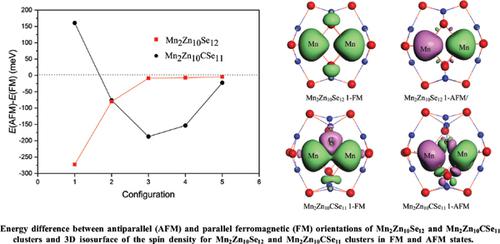Current Nanoscience ( IF 1.5 ) Pub Date : 2021-02-28 , DOI: 10.2174/1573413716999200812124413 Liangyan Chen 1 , Chao Fang 1 , Weihua Liu 1

|
Background: Mn doped ZnSe low dimensional materials are attractive for different biological labels, gene silencing and dilute-magnetic device. ZnSe clusters are one of the basic building blocks of quantum dots and even cluster-assembled nanodevices, stable structures of undoped ZnSe clusters were established by previous pioneering work, and the Mn doped ZnSe clusters had been investigated, but the stable clusters in the ferromagnetic state have not been found yet.
Objective: Our work is mainly based on Mn doped clusters (Mn2Zn10Se12) and C codoped clusters (Mn2Zn10CSe11) structure, magnetic properties through theoretical calculations.
Methods: First principle density functional theory calculation with Dmol3 is used to execute all calculations.
Results: Mn atoms prefer to substitute the nearest neighbor Zn atom sites in the rhombi part, and C atom prefers to occupy Se atom sites with shortest Mn-C bond length in Zn12Se12 nanocluster doping. Mn doped clusters (Mn2Zn10Se12) are in antiferromagnetic states and the most stable C codoped clusters (Mn2Zn10CSe11) are in ferromagnetic states. Magnetic behavior localized at the 3d orbitals of transitional metal Mn, 4p orbital of atom Se and 2p orbital of C atom. Mn2Zn10Se12 clusters are in antiferromagnetic states as the p-d hybridization introduced Mn-Mn superexchange mechanism. For the ferromagnetism of Mn2Zn10Se12 nanocluster, hole mediated double exchange mechanism introduced by C atom p-d hole state hybridization has been suggested.
Conclusion: The codoping of C atom can stabilize the ferromagnetism of clusters through hole mediated double exchange mechanism, which may be meaningful for the exploring materials for cluster- assembled spin-electronic devices.
中文翻译:

Mn和C共掺杂Zn 12 Se 12纳米团簇的结构和磁性能的理论研究
背景:Mn掺杂的ZnSe低维材料对不同的生物标记,基因沉默和稀磁设备具有吸引力。ZnSe团簇是量子点乃至簇组装的纳米器件的基本组成部分之一,以前的先驱性工作建立了无掺杂的ZnSe团簇的稳定结构,并研究了Mn掺杂的ZnSe团簇,但在铁磁态下稳定的团簇尚未找到。
目的:我们的工作主要基于锰掺杂的团簇(Mn 2 Zn 10 Se 12)和碳共掺杂的团簇(Mn 2 Zn 10 CSe 11)的结构,并通过理论计算得出磁性。
方法:使用Dmol3的第一原理密度泛函理论计算来执行所有计算。
结果:在Zn 12 Se 12纳米团簇掺杂中,Mn原子倾向于替代菱形部分中最接近的Zn原子位点,而C原子倾向于占据Mn-C键长度最短的Se原子位点。Mn掺杂的团簇(Mn 2 Zn 10 Se 12)处于反铁磁态,而最稳定的C共掺杂的团簇(Mn 2 Zn 10 CSe 11)处于铁磁态。磁性行为集中在过渡金属Mn的3d轨道,Se的4p轨道和C原子的2p轨道。Mn 2 Zn 10 Se 12pd杂交引入了Mn-Mn超交换机制,团簇处于反铁磁状态。对于Mn 2 Zn 10 Se 12纳米簇的铁磁性,已经提出了通过C原子pd空穴状态杂交引入的空穴介导的双交换机制。
结论:C原子的共掺杂可以通过空穴介导的双交换机制稳定团簇的铁磁性,这对于探索团簇组装的自旋电子器件的材料可能具有重要意义。



























 京公网安备 11010802027423号
京公网安备 11010802027423号